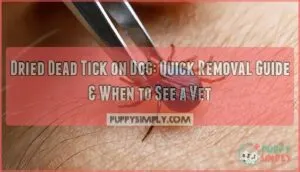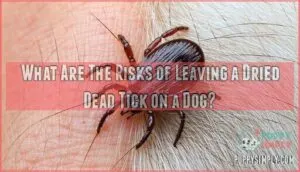This site is supported by our readers. We may earn a commission, at no cost to you, if you purchase through links.

You’ll need to remove it carefully using fine-tipped tweezers, grasping as close to the skin as possible and pulling straight up with steady pressure. Don’t twist or jerk, as this can leave mouthparts embedded.
Clean the bite area with rubbing alcohol afterward. Dead ticks can’t transmit diseases, but leaving them attached may cause irritation or infection.
Watch for redness, swelling, or discharge over the next few days. The removal process is straightforward, but there are specific techniques that make all the difference, and following these steps can prevent potential complications.
Table Of Contents
- Key Takeaways
- What Do Dead Ticks Look Like on Dogs?
- Why Are There Dried Dead Ticks on My Dog?
- How to Remove an Embedded Dead Tick From Your Dog
- What Are The Risks of Leaving a Dried Dead Tick on a Dog?
- Common Diseases Affecting Dogs’ Cardiovascular Systems
- Diagnostic Tests for Evaluating The Cardiovascular System
- Aftercare Tips for Removing a Dead Tick From Your Dog
- Do I Need to Take My Dog to The Veterinarian After Removing a Dead Tick?
- Steps for Safely Removing Dead Ticks From Your Dog
- Frequently Asked Questions (FAQs)
- What happens if a tick dies on a dog?
- What does a dead embedded tick look like on a dog?
- Can a dead tick look like a scab?
- What if a tick is embedded and dead?
- Are dead ticks contagious?
- Is there any danger in leaving a dead tick on a dog?
- What are the symptoms of tick-borne illness in dogs?
- Are there any home remedies to remove dead ticks from dogs?
- What is the best way to prevent ticks from attaching to dogs?
- Can dead ticks still transmit diseases to dogs?
- Conclusion
Key Takeaways
- You’ll recognize a dried dead tick as a small, dark, shriveled bump that feels firm and appears silvery-gray with curled legs tucked underneath – it won’t move and looks brittle compared to live ticks.
- You must remove dead ticks carefully using fine-tipped tweezers, grasping as close to your dog’s skin as possible and pulling straight up with steady pressure without twisting or jerking.
- You shouldn’t leave dead ticks attached because they can still cause skin irritation, bacterial infections, allergic reactions, and delayed healing even though they can’t transmit diseases.
- You need to clean the bite area with rubbing alcohol after removal and watch for redness, swelling, or discharge over the next few days – contact your vet if these warning signs appear.
What Do Dead Ticks Look Like on Dogs?
Finding a dried dead tick on your dog can be tricky since they look quite different from live ones.
Dead ticks shrivel into gray, brittle shells that barely resemble their former plump selves.
Dead ticks appear shriveled and flattened with a silvery-gray color, unlike the plump brown appearance of live ticks.
Their legs curl tightly under their bodies, creating a stiff, brittle appearance.
The engorgement status affects their size – previously engorged ticks remain larger even when dried.
These color variations and leg position changes make tick identification challenging, but the lack of movement and dried appearance are telltale signs you’re dealing with a dead parasite.
Why Are There Dried Dead Ticks on My Dog?
Discovery of a dried dead tick on your dog can happen for several reasons.
These parasites follow a natural lifecycle that sometimes ends while they’re still attached to your pet.
Here’s why you might find dead ticks on your dog:
- Tick Preventatives – Flea and tick medications kill parasites after they bite, causing them to die while still embedded in your dog’s skin
- Natural Death – Ticks can die from environmental factors like temperature changes or reaching the end of their natural lifespan
- Recent Infestation – Some ticks from a recent infestation may have already died before you discovered them during tick identification.
Ticks can transmit diseases, so monitor for infection after removal.
How to Remove an Embedded Dead Tick From Your Dog
Removing an embedded dead tick from your dog requires proper technique and tool sterilization to prevent complications. These parasitic hitchhikers won’t release their grip easily, even after death.
- Sterilize fine-tipped tweezers with rubbing alcohol before starting the tick removal process
- Grasp the tick’s body as close to your dog’s skin as possible without squeezing too hard
- Pull steadily upward with constant pressure until the embedded head releases completely
If the embedded head breaks off, don’t panic. For ideal results, consider purchasing specialized tools.
Clean the area thoroughly and monitor for infection signs. Proper wound care and infection prevention are essential after removing any dried dead tick.
What Are The Risks of Leaving a Dried Dead Tick on a Dog?
While most pet owners think dried dead ticks are harmless, leaving them on your dog creates several health risks that shouldn’t be ignored.
Don’t ignore dried dead ticks on your dog – they’re not as harmless as they appear.
Dead ticks can still cause infection potential through bacteria trapped in their mouthparts, leading to localized skin problems. Your dog might develop allergic reactions to tick proteins, causing swelling and intense itching around the bite area.
The tick’s attachment location is often around the ears, neck, head, belly, and legs. Granuloma formation can occur when your dog’s immune system treats the embedded tick as a foreign object, creating painful lumps under the skin.
Scarring risks increase when dead ticks remain attached, especially if your dog scratches or chews the area. Delayed healing is common since the tick’s presence prevents normal tissue repair.
| Risk Factor | Potential Outcome |
|---|---|
| Bacterial infection | Skin irritation, pus formation |
| Allergic reactions | Swelling, redness, itching |
| Granuloma formation | Painful lumps, tissue inflammation |
| Scarring | Permanent skin damage |
| Delayed healing | Prolonged recovery time |
Remove dried dead ticks promptly to prevent these dog health concerns from developing into serious complications.
Common Diseases Affecting Dogs’ Cardiovascular Systems
Your dog’s heart works hard every day to pump blood throughout their body, but several conditions can affect this essential organ.
Understanding these common cardiovascular diseases helps you recognize warning signs early and seek proper veterinary care when your pet needs it most, which is crucial for their health and well-being, especially in terms of proper veterinary care.
Heartworm Disease
Why should heartworm disease concern dog owners dealing with tick issues? Heartworm prevention becomes vital when your dog’s cardiovascular system is already stressed from tick-related problems.
These parasitic worms, transmitted through mosquito bites, settle in your dog’s heart and pulmonary arteries, creating a dangerous combination with existing tick concerns.
Understanding the heartworm lifecycle helps you protect your pet effectively:
- Heartworm symptoms include persistent coughing and unexplained fatigue
- Heartworm testing should occur annually during routine vet visits
- Heartworm treatment requires immediate veterinary intervention if detected
- Heartworm prevention through monthly medications protects against infection
Dogs recovering from dried tick removal or battling tickborne diseases like Lyme disease face increased vulnerability.
Certain breeds are prone to developing heart valve disease.
Monthly preventatives offer the best protection, especially for dogs with compromised immune systems from tick encounters.
Regular heartworm testing guarantees early detection before symptoms appear.
Dilated Cardiomyopathy
Dilated cardiomyopathy (DCM) strikes when your dog’s heart muscle weakens and can’t pump blood effectively.
DCM genetics play a role, with certain breed predispositions affecting large dogs like Dobermans and Great Danes.
Taurine deficiency may contribute to this condition.
Watch for coughing, fatigue, and difficulty breathing.
While maintaining tick prevention helps protect overall canine health from tickborne diseases that stress the cardiovascular system, DCM prognosis varies.
Treatment options include medications to support heart function, though this condition requires lifelong management in most cases.
Mitral Valve Illness
Mitral valve illness affects your dog’s heart differently than other cardiovascular conditions.
This disease involves the valve between your dog’s left atrium and left ventricle, which controls blood flow direction.
When this valve weakens or thickens, it can’t close properly, causing blood to leak backward—a condition called Mitral Regurgitation.
Small breed dogs face higher risks as they age.
Watch for persistent coughing, especially after exercise or excitement.
Difficulty breathing and reduced energy levels signal potential Valve Prolapse or Chordae Rupture.
Your vet can detect Heart Murmurs during routine checkups, making early diagnosis possible.
Canine MVI progresses slowly, so regular veterinary visits help catch problems before they become serious health threats requiring immediate intervention.
Arrhythmias
Recognizing irregular heartbeats in your dog can save their life. Arrhythmias occur when your pup’s heart rhythm becomes abnormal, affecting how efficiently blood pumps through their body.
These conditions rank among the five most common heart diseases in dogs.
Causes include underlying heart disease, electrolyte imbalances, and complications from tick-borne illnesses like Lyme disease in dogs.
Symptoms you’ll notice are rapid breathing, weakness, and sudden collapse during activity.
Diagnosis requires electrocardiography (ECG) to measure heart rhythm patterns. Your vet will listen carefully to detect irregular beats during routine examinations.
Treatment involves medications to regulate heart rhythm, while severe cases may need pacemaker implantation.
Prevention starts with regular vet checkups and proper dog tick prevention to avoid tick bite symptoms that could lead to heart complications.
Hypertension
High blood pressure affects dogs just like it does humans, often sneaking up without obvious warning signs.
This condition puts extra strain on your dog’s heart, kidneys, and other essential organs, making early detection important for your pet’s health.
Key factors to watch for include:
- Causes – Kidney disease, thyroid problems, and certain medications can trigger hypertension
- Symptoms – Look for excessive panting, weakness, or sudden vision changes in your dog
- Diagnosis – Your vet uses specialized equipment to measure blood pressure accurately
- Treatment – Medications help control blood pressure and protect organ function
- Prevention – Regular checkups, healthy weight maintenance, and proper diet support cardiovascular health
Managing hypertension requires ongoing veterinary care, but most dogs respond well to treatment when caught early.
Diagnostic Tests for Evaluating The Cardiovascular System
When your vet suspects cardiovascular issues in your dog, they’ll run several diagnostic tests to get the full picture.
Blood pressure measurements help detect hypertension, while cardiac biomarkers like troponin reveal heart muscle damage.
An echocardiogram uses sound waves to visualize your dog’s heart structure and function, showing valve problems or enlarged chambers.
ECG monitoring tracks electrical activity, catching irregular heartbeats that might otherwise go unnoticed.
Radiography analysis through chest X-rays reveals heart size and lung congestion.
Your vet might also order blood tests checking liver function, glucose levels, and electrolytes.
These tests work together like puzzle pieces, helping identify whether symptoms stem from heart disease or other conditions.
Interestingly, tick infestations can complicate cardiovascular health.
Tickborne illnesses sometimes cause heart inflammation, making proper dead tick identification and removal essential for your dog’s overall cardiac wellness.
Aftercare Tips for Removing a Dead Tick From Your Dog
After removing a dead tick from your dog, proper aftercare guarantees the bite wound heals without complications.
Clean the area immediately with 70% isopropyl alcohol or hydrogen peroxide to disinfect and prevent infection.
Monitor the site daily for signs of trouble, watching for unusual redness or swelling.
Normal healing shows mild bumps or scabs—don’t panic if you see these changes.
Essential aftercare steps include:
- Apply thin layer of antibiotic ointment for healing promotion
- Keep the area clean and dry during recovery
- Watch for excessive itching that needs itch relief treatment
It’s also important to use appropriate dog antiseptics for wound care.
Do I Need to Take My Dog to The Veterinarian After Removing a Dead Tick?
After proper tick removal and cleaning, you don’t always need to rush to the vet. Watch your dog for specific vet visit signs over the next few days. If the tick bite area becomes red, swollen, or starts draining, schedule veterinary care immediately.
These symptoms indicate infection risk that requires professional treatment. Mouthpart retention from dead ticks rarely causes serious problems, but monitor the site closely.
The area might develop a small bump or scab – that’s normal healing. However, if your dog shows signs like lethargy, loss of appetite, or lameness, contact your vet for disease monitoring.
Consider preventative care by discussing tick prevention products with your veterinarian. Regular annual wellness checks are also important for early detection of health changes. They can recommend the best tick-related veterinary care options for your area.
Remember, most tick removal situations don’t require emergency visits, but staying alert to changes in your dog’s health keeps everyone safe.
Steps for Safely Removing Dead Ticks From Your Dog
Your dog’s dried dead tick removal requires proper preparation and technique. Gather tick removal tools like fine-tipped tweezers, rubbing alcohol, and gloves before starting.
The process involves careful tick location identification, maintaining a safe grasp near the skin, and using steady pulling technique to extract the entire parasite including tick mouthparts. For specialized tools, consider using dedicated tick removal options.
- Tools Needed: Fine-tipped tweezers, rubbing alcohol, disposable gloves, and antiseptic solution
- Tick Location: Check common spots like neck, ears, chest, and between toes thoroughly
- Safe Grasp: Hold tweezers close to skin level, avoiding the tick’s swollen body
- Pulling Technique: Apply steady upward pressure without twisting or jerking motions
- Disinfection Steps: Clean bite area with alcohol and monitor for infection signs
Frequently Asked Questions (FAQs)
What happens if a tick dies on a dog?
Like a stubborn hitchhiker refusing to leave, a dead tick becomes nature’s unwelcome parting gift.
It’ll shrivel up, turn silvery-gray, and stay glued to your pup’s skin until you remove it with tweezers and disinfect the area, which can be considered a parting gift.
What does a dead embedded tick look like on a dog?
A dead embedded tick appears silvery-gray with curled, stiff legs tucked under its shrunken body.
You’ll notice it doesn’t move and feels brittle, looking dried or wrinkled compared to live ticks, with a clear distinction in its appearance.
Can a dead tick look like a scab?
Yes, a dead tick can resemble a scab on your dog’s skin.
However, you’ll notice the tick’s body structure and curled legs underneath, unlike a smooth, flat scab that forms naturally over wounds.
What if a tick is embedded and dead?
Like finding a splinter that won’t budge, you’ll need to remove that embedded dead tick carefully.
Use tweezers to grasp it close to your dog’s skin, pull straight up gently, then disinfect the area.
Are dead ticks contagious?
No, dead ticks can’t actively spread diseases since they’re no longer feeding or injecting pathogens.
However, you’ll still need to remove them promptly to prevent skin irritation and potential bacterial infections.
Is there any danger in leaving a dead tick on a dog?
While removing that unwelcome hitchhiker isn’t urgent, you shouldn’t leave it there indefinitely.
Dead ticks can still cause skin irritation, infection, and embedded mouthparts may create ongoing problems requiring veterinary attention, including issues that may lead to infection.
What are the symptoms of tick-borne illness in dogs?
Watch for fever, lethargy, loss of appetite, lameness, and joint swelling in your dog.
You might notice bruising, nosebleeds, or difficulty breathing.
These symptoms can appear days to weeks after tick exposure, so stay vigilant.
Are there any home remedies to remove dead ticks from dogs?
Tweezers triumph over home remedies when removing dead ticks.
You’ll need fine-tipped tweezers, rubbing alcohol, and steady hands.
Skip oils, matches, or nail polish—they’re ineffective and dangerous.
Pull straight up gently near the skin’s surface for safe removal.
What is the best way to prevent ticks from attaching to dogs?
Use tick preventatives like flea and tick collars, topical treatments, or oral medications prescribed by your vet.
Check your dog regularly after walks, especially around ears, neck, and paws where ticks commonly attach.
Can dead ticks still transmit diseases to dogs?
Dead ticks can’t actively transmit diseases, but they still pose risks. Embedded mouthparts may cause infection, and residual blood could release pathogens if you squeeze the tick during removal.
Conclusion
Removing a dried dead tick on dog requires patience and the right technique to prevent complications.
Your dog’s health depends on proper removal using fine-tipped tweezers and steady pressure.
Clean the area thoroughly and monitor for signs of infection over the following days.
While dead ticks can’t transmit diseases, leaving them attached risks irritation and secondary infections.
When in doubt, consult your veterinarian for professional guidance and peace of mind regarding your pet’s wellbeing.
- https://www.mayoclinic.org/tick-species/sls-20147911
- https://www.ncbi.nlm.nih.gov/pmc/articles/PMC5947171/
- https://web.uri.edu/tickencounter/fieldguide/id-guide/
- https://pangovet.com/?utm_source=dogster&utm_medium=article&utm_campaign=dried-tick-on-dog-control
- https://petkeen.com/dogs-with-ticks-and-the-risk-of-lyme-disease/













